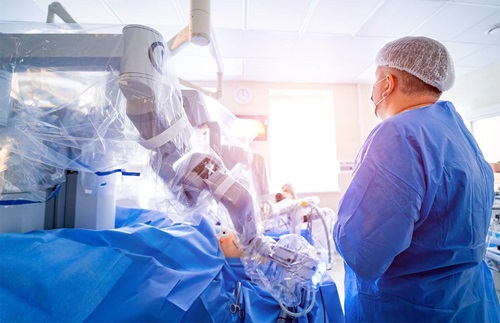Hip pain can be debilitating, limiting your mobility and hindering your enjoyment of everyday activities. Traditional hip replacement surgery has been a successful treatment for decades, but advancements in medical technology are introducing a groundbreaking option: robotic-assisted surgery.
Unveiling the Power of Robotics in Hip Replacement
Robotic hip replacement surgery combines the expertise of highly skilled orthopedic surgeons with the incredible precision and flexibility of robotic systems. Here's a breakdown of the process:
-
Pre-Surgical Planning: Before surgery, advanced imaging techniques like CT scans or MRIs create a detailed, three-dimensional model of your unique hip joint. This digital blueprint allows surgeons to develop a personalized surgical plan, meticulously optimizing the size, fit, and placement of the implant specifically for your anatomy.
-
The Role of the Robot: During surgery, the robotic system acts as an extension of the surgeon's hand, assisting them in executing the pre-planned steps with unparalleled accuracy. While the surgeon remains in complete control throughout the procedure, the robotic arm helps them perform precise bone cuts, prepare the hip socket with utmost precision, and accurately position the implant. Real-time feedback and monitoring ensure the surgery unfolds exactly as planned, minimizing errors and leading to improved outcomes and reduced complications.
Why Choose Robotic Hip Replacement?
This innovative approach offers a multitude of benefits for patients:
-
Enhanced Precision: Robotic technology allows surgeons to achieve sub-millimeter accuracy, minimizing errors and optimizing implant placement and alignment. This translates to a more stable and functional joint, potentially reducing the risk of future problems.
-
Personalized Treatment: Unlike traditional surgery with a "one-size-fits-all" approach, robotic surgery tailors the entire procedure to your unique anatomy. This customization leads to a better fit for the implant, potentially improving long-term function and reducing the risk of complications.
-
Minimally Invasive Approach: Robotic-assisted surgery typically involves smaller incisions compared to traditional surgery. This translates to less trauma to surrounding tissues, leading to faster recovery times, shorter hospital stays, and potentially less post-operative pain.
-
Improved Implant Longevity: Precise alignment and placement of the implant minimizes wear and tear, potentially extending its lifespan and reducing the need for revision surgery down the line.
-
Faster Recovery and Rehabilitation: With less tissue damage and improved implant alignment, patients may experience a quicker recovery and rehabilitation process compared to traditional surgery. This translates to getting back to your daily activities and enjoying an active life sooner.
The Future of Orthopedic Surgery with Robotics
The field of robotic surgery is constantly evolving, holding immense promise for the future of orthopedics. Robotic systems are becoming increasingly sophisticated, offering applications beyond hip replacement surgery. We can expect to see similar benefits of robotic assistance in procedures like knee replacements, spine surgery, and potentially many more in the years to come.
Taking Control of Your Active Life Again
Robotic hip replacement surgery represents a significant advancement in orthopedic care. It offers patients a more precise, personalized, and effective treatment option for hip joint degeneration. By harnessing the power of robotics, surgeons can achieve optimal surgical outcomes, reduce complications, and enhance patient satisfaction. If chronic hip pain is limiting your mobility, exploring robotic hip replacement surgery could be the key to regaining your active life and living to the fullest.
Next Steps:
- Consult with a qualified orthopedic surgeon specializing in robotic hip replacement surgery to discuss your specific situation and determine if this option is the right fit for you.
- Research various healthcare facilities offering robotic hip replacement surgery and compare their expertise and experience with this technology.
- Educate yourself further about the recovery process and rehabilitation protocols involved in robotic hip replacement surgery.
Regaining your mobility and enjoying life without limitations is within reach. Take the first step towards a pain-free future by exploring the possibilities of robotic hip replacement surgery.



